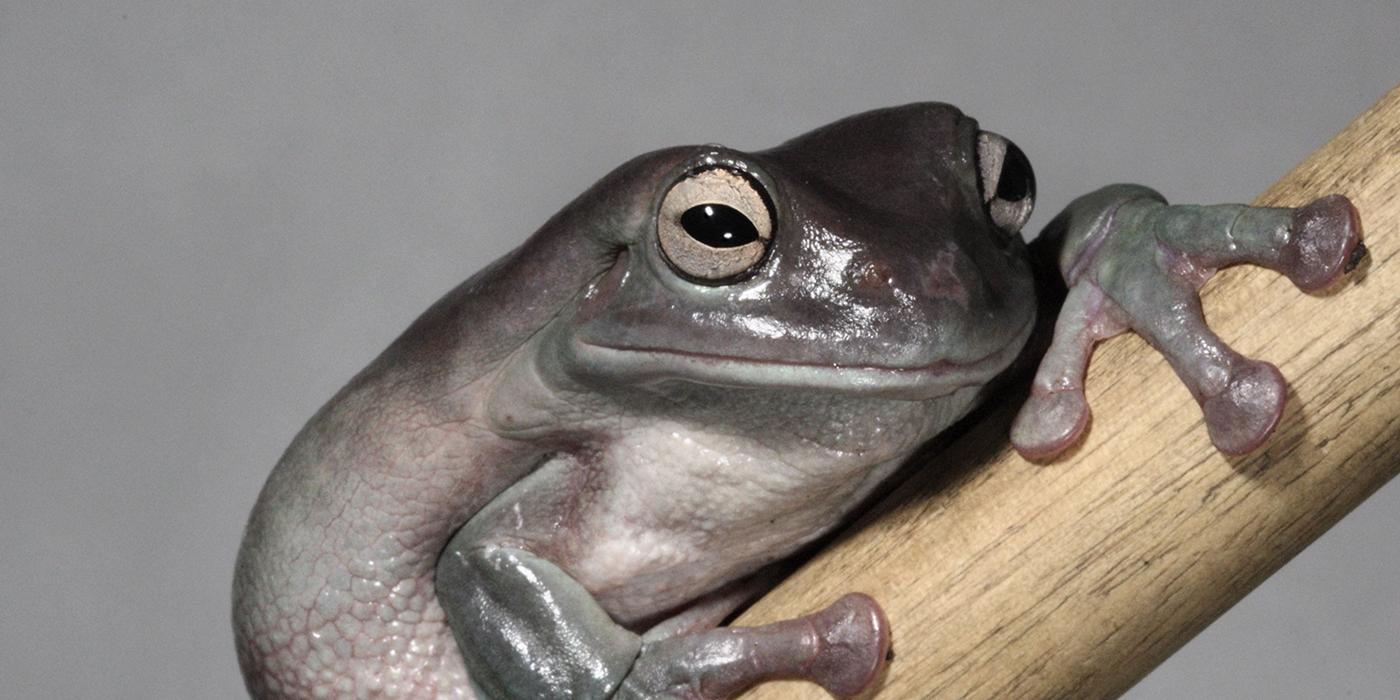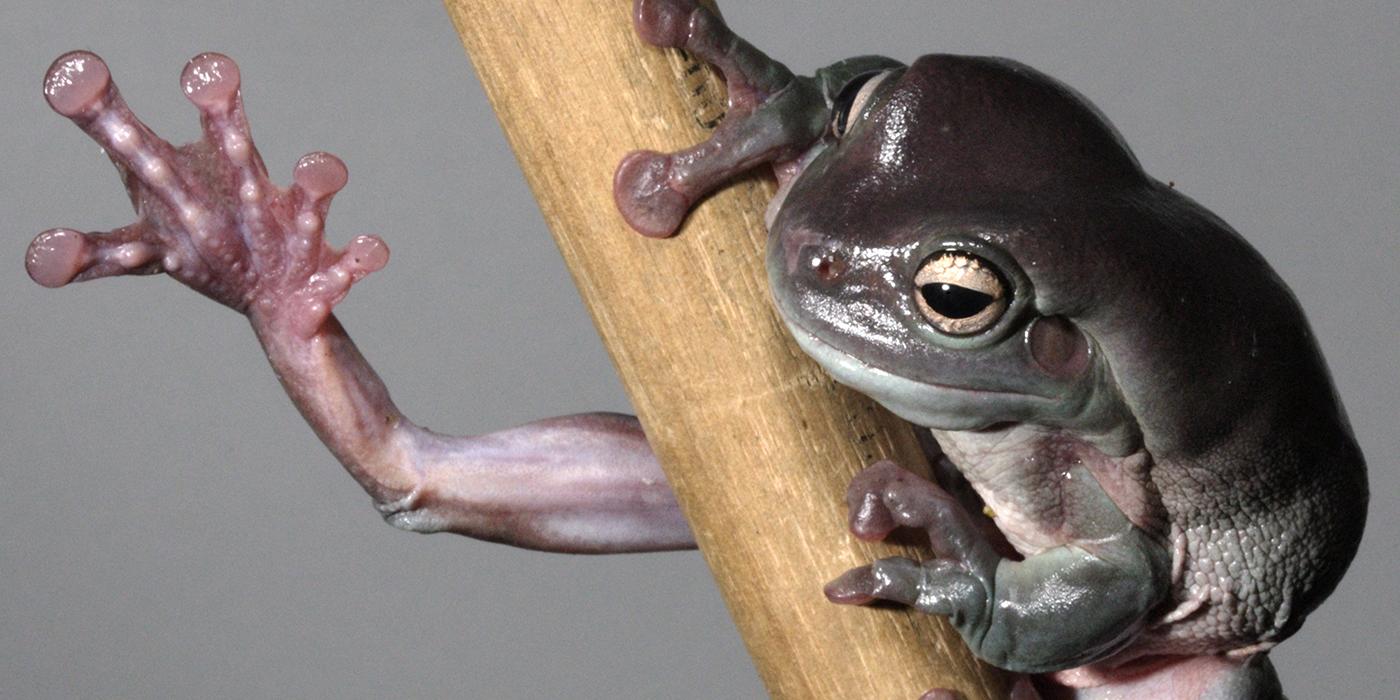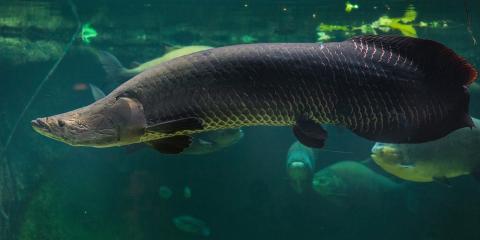Physical Description
These frogs range in color from a light blue to emerald green or almost gray across their backs and milky white bellies. Females have white throats, and males have a grayish wrinkled vocal sac underneath their throat.
Like many other tree frogs, White's tree frogs can change color to some degree.
These frogs have enormous toe pads with partial webbing between fingers and almost complete webbing between toes. The eye has a horizontal pupil; most other tree frogs have vertical pupils. The fatty ridge over the eye is a distinctive feature of the species.
Size
White's tree frogs are rather large, ranging in length from 3 to 4.5 inches (7 to 11.5 centimeters). Females are usually slightly bigger than the males.
Native Habitat
White's tree frog is native to Australia and southern New Guinea and has been introduced to New Zealand. These tree frogs can live in either seasonally dry or wet habitats. They prefer moist, forested environments but have skin that can adjust to drier situations. White's tree frogs do not typically live in or near water, but instead live in trees. Rain collects on leaves, in cup-shaped plants and in crevices in tree trunks, allowing the frogs access to water. These places are replenished with water from the almost daily rains and the frogs always have a source of water to keep themselves moist.
White's tree frogs are not strictly limited to tropical rain forests. In other forests, these frogs avoid desiccation in the dry season by taking refuge in tree hollows or secreting a milky substance called "caerviein." They cover their bodies in a cocoon that prevents them from losing too much moisture.
This frog's adaptability allows it to share suburban and agricultural areas with humans. They have been found in bathrooms, water tanks and city reservoirs. During the hot summer months, they can appear on the verandas of homes, or actually enter homes, looking for moisture.
Lifespan
The average life span is about 16 years, but one is recorded to have lived 21 years in human care.
Communication
When threatened, they emit an ear-piercing distress call.
Food/Eating Habits
They eat mainly insects such as moths, locusts and roaches. At the Smithsonian's National Zoo, they eat crickets and cockroaches.
Reproduction and Development
White's tree frogs reach sexual maturity in their second year. In the summer rainy season, they feast for a few days then start to breed. During the mating season, males grow a black pad on their thumb to help in gripping the females during mating, which can last for days while the female lays her eggs.
The female expels her eggs with such force that they go through the deposited sperm cloud and stop up to 1.5 feet (0.5 meters) away. A clutch can contain from 150 to 300 eggs. Once fertilized, the eggs sink to the bottom. Hatching begins about 28 to 36 hours after laying. Metamorphosis can occur in two to three weeks in good conditions.
Conservation Efforts
White's tree frogs live in a broad range of habitats and seem to have a healthy population. Despite this, they are threatened by pollution, by predation from domestic pets such as cats and dogs, habitat loss, by the international pet trade, and from inadvertent relocation of tadpoles and eggs when vegetation is harvested.
Like many other amphibian species, White's tree frogs are at risk due to a fungal disease. In 1999, Smithsonian Conservation Biology Institute scientists discovered a then-mysterious disease infecting and eventually killing poison arrow frogs and White's tree frogs. Through their efforts, cutaneous chytridiomycosis was documented for the first time as a vertebrate pathogen.
Scientists began developing a treatment — the same antifungal that is used to kill athletes' foot in humans can be used with the frogs and toads. Now, there are several other treatments in use among captive amphibian collections. The Smithsonian's National Zoo and Conservation Biology Institute continues to be involved in research seeking ways to combat chytrid in wild populations.
Help this Species
- Reduce, reuse and recycle — in that order! Cut back on single-use goods, and find creative ways to reuse products at the end of their life cycle. Choose recycling over trash when possible.
- Choose your pets wisely, and do your research before bringing an animal home. Exotic animals don’t always make great pets. Many require special care and live for a long time. Tropical reptiles and small mammals are often traded internationally and may be victims of the illegal pet trade. Never release animals that have been kept as pets into the wild.
- Support organizations like the Smithsonian’s National Zoo and Conservation Biology Institute that research better ways to protect and care for this animal and other endangered species. Consider donating your time, money or goods.




